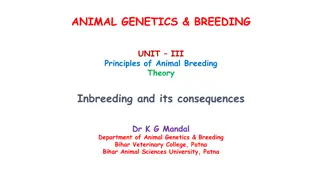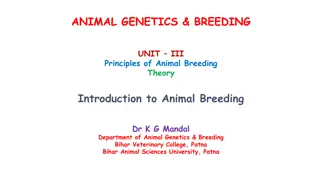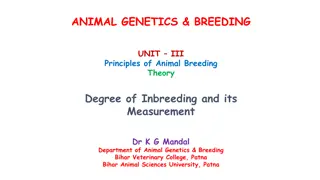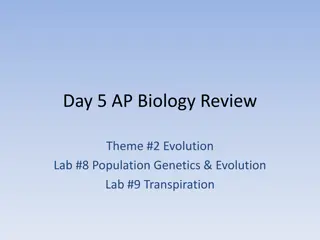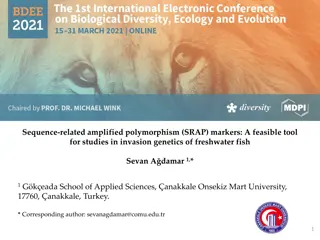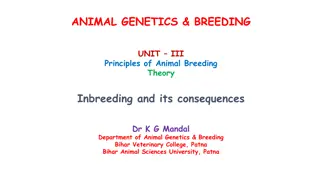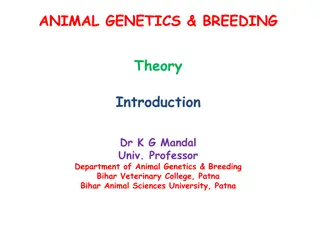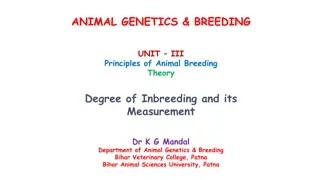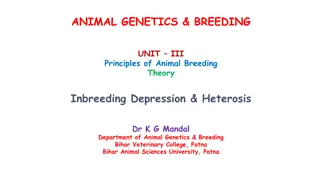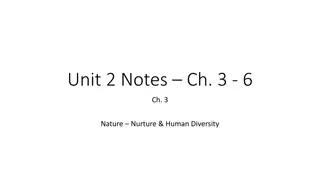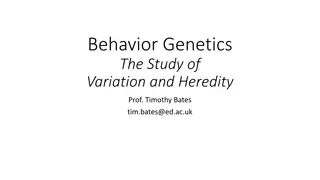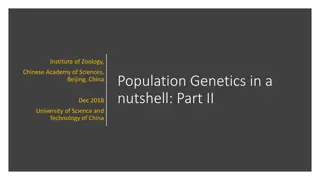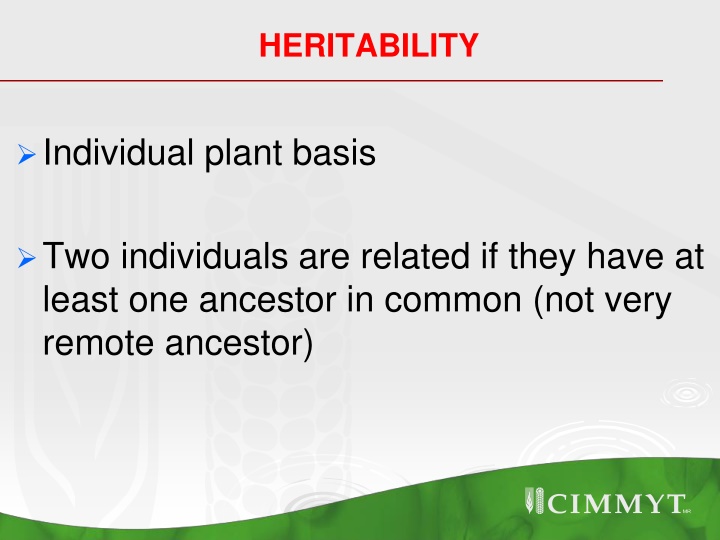
Inbreeding and Heritability in Plants
Dive into the concept of inbreeding and heritability in plants, exploring the quantification of inbreeding, proportion of heterozygous genotypes, and the effects of inbreeding on genetic diversity. Learn how to calculate inbreeding coefficients and the probability of identical by descent between related individuals.
Download Presentation

Please find below an Image/Link to download the presentation.
The content on the website is provided AS IS for your information and personal use only. It may not be sold, licensed, or shared on other websites without obtaining consent from the author. If you encounter any issues during the download, it is possible that the publisher has removed the file from their server.
You are allowed to download the files provided on this website for personal or commercial use, subject to the condition that they are used lawfully. All files are the property of their respective owners.
The content on the website is provided AS IS for your information and personal use only. It may not be sold, licensed, or shared on other websites without obtaining consent from the author.
E N D
Presentation Transcript
HERITABILITY Individual plant basis Two individuals are related if they have at least one ancestor in common (not very remote ancestor)
HOW TO QUANTIFY INBREEDING? Proportion of heterozygous Inbreeding coefficient as a probability of identical by descent
Proportion of heterozygous Proportion of heterozygous under inbreeding vs Proportion of heterozygous under random mating (RM) HIP=Freq. of heterozygous genotypes in a inbred population (IP) HRM=Freq. of heterozygous genotypes in a RM population
Proportion of heterozygous Effect of inbreeding can be defined as the proportion reduction in heterozygosity relative to RM. Mathematically is H H H H RM RM IP IP = H H 1 1 F F = IP IP H H H H RM RM RM RM F measures the fractional reduction in heterozygosity of an inbred population relative to a RM population with the same allele freq.
Proportion of heterozygous HRM=2pq proportion of Aa under RM HIP=HRM-FxHRM=HRM(1-F)= =2pq(1-F) proportion of Aa under inbreeding (IP) Freq. of homozygous genotypes in an inbred population can be expressed in terms of F
Proportion of heterozygous Suppose that the proportion AA genotype is denoted as PAA Because p is the allele freq. of A, by F=1-(HIP/HRM) then p=PAA + HIP/2 but HIP=2pq(1-F) so PAA = p-2pq(1-F)/2= p-pq(1-F)=p-pq+pqF = p-p(1-p)+pqF= p2+pqF PAA = p2+pqF= p2+p(1-p)F= p2+pF-p2F =p2(1-F)+pF Paa=q2(1-F)+qF
Summary Proportion of heterozygous PAA = p2(1-F)+pF = p2+pqF PAa= 2pq-2pqF Paa= q2(1-F)+qF = q2+pqF
Summary Proportion of heterozygous F=0 F=1 PAA = p2(1-F)+pF p2 p PAa = 2pq 2pq 0 Paa = q2(1-F)+qF q2 q
Inbreeding coefficient as a probability IBD=two alleles are from the same ancestor allele by DNA replication in one of the common ancestors = IDENTICAL BY DESCENT IBS=two alleles might not be replicates of a single ancestor allele in which case the alleles are not IBD. They are IDENTICAL BY STATE=IBS F=probability that two alleles of a gene in an inbred organism are IBD.
Inbreeding coefficient as a probability F=measures the probability of IBD relative to some ancestral population assuming the ancestral population is not inbred, that is F 0 A1A1 IBD HOMOZYGOUS A2A2 IBD HOMOZYGOUS A1 A2 A1 A1 A1 A1 A2 A1 A1 A2 A2 A1 A1A1 IBS HOMOZYGOUS A1A2 non-IBD HETEROZYGOUS Alleles in the ancestral population all assumed not to be IBD Genotypes in the present popualtion
ORIGIN OF AN ALLELE IDENTICAL BY DESCENT (IBD) ALIKE IN STATE (IBS) ---- not IBD A1A1 A1 A1A2 A1A2 A1A1 INBRED because the two alleles are IBD A1A1 non-IBD because the two alleles are non-IBD
COEFFICIENT OF PARENTAGE COEFFICIENT OF COANCESTRY It measures the IBD within one individual (fXX) or between two individuals (fXY) COP between X and Y is the probability that at a single locus a random alleles from X is IBD with a random allele from Y fXY=0 no relationship; fXY=1 at a given locus indicates that the 2 individuals are homozygous for copies of the same allele found in an ancestry; fXY=1 across all loci indicates that the 2 individuals are fully inbred and genetically identical
COEFFICIENT OF INBREEDING (F) F probability that a single locus, the two alleles in the same individual are identical by descent F measures IBD within an individual Inbreeding only occurs when the 2 parents have alleles that are IBD F is the proportion by which heterozygosity is reduced upon inbreeding relative to a HW equilibrium
PROBABILITY OF IDENTICAL BY DESCENT A: a1 a2 B:b1b2 C: c1 c2 D:d1d2 X: x1 x2 Y:y1 y2 x y Z: z1 z2 x1 x2 a1 if X is a1 a1 x1 x2 a1 anda2 if X is a1 a2 x1 x2 a2 if X is a2 a2 One allele chosen at random from X and denoted as x One allele chosen at random from Y and denoted as y
COP between X and Y Is the probability that alleles x and y are IBD fxy=P(x y) Alleles x and y become IBD trough four possible events: 1) x1 is x ; y1 is y; x1 y1 2) x1 is x ; y2 is y; x1 y2 3) x2 is x ; y1 is y; x2 y1 4) x2 is x ; y2 is y; x2 y2
COP between X and Y fxy=P(x y) =P(x1= x, y1= y, x1 y1)+ P(x1= x, y2= y, x1 y2)+ P(x2= x, y1= y, x2 y1)+ P(x2= x, y2= y, x2 y2) P(x1= x), P(x2= x), P(y1= y), P(y2= y)= Then fxy=1/4[P(x1 y1)+P(x1 y2)+ P(x2 y1)+ P(x2 y2)]
COP between X and X (one individual with itself) Substitute x1for y2 and x2 for y2 fxx=1/4[P(x1 x1)+P(x1 x2)+ P(x2 x1)+P(x2 x2)] fxx =1/4[ 1 + Fx + Fx + 1] fxx =1/4[2+2 Fx] fxx =1/2[1+Fx] fxx=1/2 if Fx=0 the individual is not inbred fxx=1 if Fx=1 the individual is fully inbred
F coefficient of an offspring X: x1 x2 Y:y1 y2 Z: z1 z2 Fz =P(z1 z2) =P(z1=x1, z2=y1, x1 y1)+ P(z1=x1, z2=y2, x1 y2)+ P(z1=x2, z2=y1, x2 y1)+ P(z1=x2, z2=y2, x2 y2)
F coefficient of an offspring P(z1=x1), P(z1=x2), P(z2=y1), P(z2=y1) = Then Fz=1/4[P(x1 y1)+P(x1 y2)+ P(x2 y1)+ P(x2 y2)] Fz = fxy COEFFICIENT OF INBREEDING OF A OFFSPRING IS EQUAL TO THE COEFFIENT OF COANCESTRY BETWEEN ITS PARENTS
Two ways to calculate fxy from pedigree Relationship among the four parent of two individual A x B=X C x D=Y Alleles in parent X and Y become IBD through four events Alleles in A and C are IBD Alleles in A and D are IBD Alleles in B and C are IBD Alleles in B and D are IBD fxy=1/4[fAC + fAD + fBC + fBD]
Two ways to calculate fxy from pedigree Relationship between an individual and another individual parent A x B=X X x Y=Z Y is not descendent of X Alleles in parent X and Y become IBD through two events Alleles in A and Y are IBD Alleles in B and Y are IBD fxy=1/2[fAY+fBY]
Two ways to calculate fxy from pedigree Relationship between an individual and another individual parent fxz 1/2[fAZ + fBZ] because the coefficient used in estimation of fAZ and fBZ are dependent on the coefficient being estimated fxy fxz Coancestry between a parent and a offspring fxz=1/2[fxx + fxy]=1/2[1/2(1+Fx )+ fxy]
fxy(PO) Coancestry between a parent and a offspring 1/4 fxz(PO) =1/2[fxx + fxy]=1/2[1/2(1+Fx )+ fxy] If Fx=0 (NON-INBRED) and fxy =0 (X and Y are unrelated) then fxz(PO) =1/2[1/2+ fxy]=1/4 If Fx=1 (INBRED) and fxy =0 (X and Y are unrelated) then fxz(PO) =1/2[1/2(2)+ fxy]=1/2
fxy(FS) Coancestry between full sibs 1/4 X and Y are full-sibs if both have the same parent A x B A x B=X A x B=Y fxy(FS)=1/4[fAA + fAB + fBA + fBB] =1/4[1/2(1+FA)+ fAB + fBA + 1/2(1+FB)]
fxy(FS) Coancestry between full sibs 1/4 fxy(FS)= 1/4[1/2(1+FA)+ fAB + fBA + 1/2(1+FB)] If FA=FB=0 (parents non-inbreds) and no related fAB=0 then fxy(FS)= 1/4[1/2+ 0 + 0+ 1/2]=1/4 If FA=FB=1 (parents full inbreds) and no related fAB=0 then fxy(FS)= 1/4[1+0+0+1]=1/2 and >1/2 if parents are related
fxy(HS) Coancestry between half sibs 1/8 X and Y are half-sibs if both have one parent A x B=X A x D=Y fxy(HS)=1/4[fAA + fAD + fBA + fBD] =1/4[1/2(1+FA)+ fAD + fBA + fBD] If A, B and D are unrelated then fxy(HS)=1/4[1/2(1+FA)]=1/8(1+FA) If FA=0 (A is not inbred) then fxy(HS)=1/8 If FA=1 (A is an inbred) then fxy(HS)=1/4
fxy(HS) Coancestry between half sibs 1/8 fxy(FS)= 1/4[1/2(1+FA)+ fAB + fBA + 1/2(1+FB)] If FA=FB=0 (parents non-inbreds) and no related fAB=0 then fxy(FS)= 1/4[1/2+1/2(0) + 2(0) + (0)]=1/4 If FA=FB=1 (parents full inbreds) and no related fAB=0 then fxy(FS)= 1/4[1+1]=1/2 and >1/2 if parents are related
Inbreeding from pedigree METHODS OF PATH A(g1 g2) a1 a2 C X B Y b C J K D E d e I Inbreeding of individual I is FI=P(d e) Every time there is a common ancestry in the pedigree there is a probability of F
Inbreeding from pedigree FI=P(d e)=P(d b) P(b a1) P(a1 a2) P(c a2) P(e c) = (1/2)(1/2)[1/2(1+FA)](1/2)(1/2) = (1/2)5(1+FA)=(1/32)(1+FA) P(a1 a2)=P(a1 g1)P(a2 g1)+ P(a1 g2)P(a2 g2)+ P(a1 g1)P(a2 g2)P(g1 g2)+ P(a1 g2)P(a2 g1)P(g1 g2)
Inbreeding from pedigree P(a1 a2)=P(a1 g1)P(a2 g1)+ P(a1 g2)P(a2 g2)+ P(a1 g1)P(a2 g2)P(g1 g2)+ P(a1 g2)P(a2 g1)P(g1 g2) P(a1 a2)=(1/2)(1/2)+(1/2)(1/2)+(1/2)(1/2)FA+ (1/2)(1/2)FA =(1/4)+(1/4)+(1/4)FA+(1/4)FA =(1/2)+(1/2)FA =(1/2)+(1+FA)=CII
Inbreeding from pedigree FI=(1/2)n(1+FA)=(1/2)5(1+FA)=(1/32)(1+FA) n=number of parents involved COANCESTRY METHOD FI=CDE = (1/4)[CJC+CJK+CBC+CBK] = (1/4)[0+0+CBC+0]=(1/4)CBC (1/4)CBC= (1/4) (1/4)[CXA+CXY+CAA+CAY] = (1/4) (1/4)[0+0+CAA+0] = (1/4) (1/4)[CAA] = (1/4) (1/4) (1/2) (1+FA)=(1/32) (1+FA)


